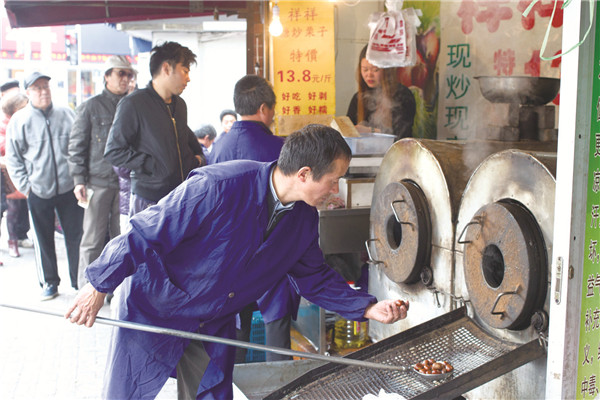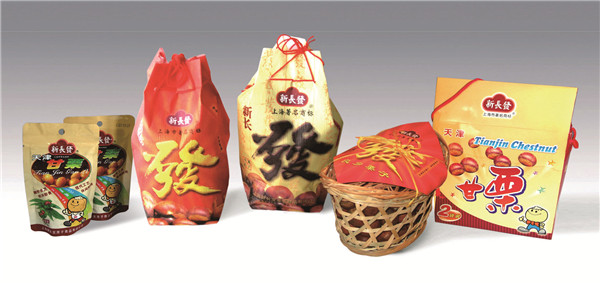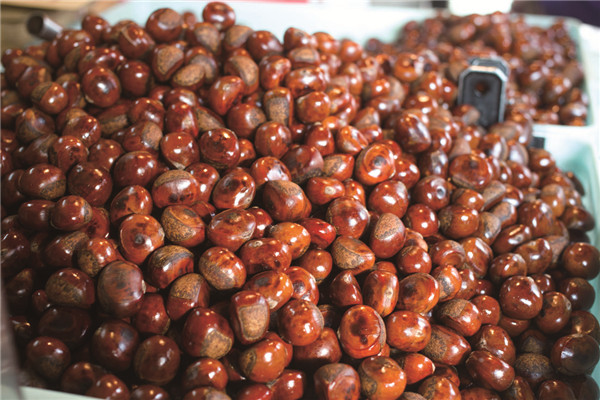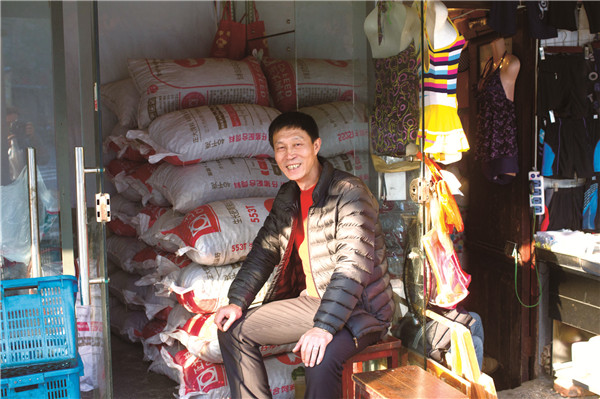Comfort food for the soul
Updated: 2015-12-12 04:29
(China Daily USA)
|
||||||||
 |
|
|
|
Zhang Rongxiang says that his chestnuts are especially delicious because of their place of origin which he has kept a secret. photos by Gao Erqiang / China Daily |
 |
| The chestnut products sold by century-old Xinchangfa. provided to China Daily |
 |
| A glistening shell is revealed after mixing the chestnuts with black sand, sugar and oil. Gao Erqiang / China Daily |
There is no snack more popular with the Shanghainese during winter than a humble bag of freshly roasted chestnuts
Xiangxiang Chestnut, a tiny shop space selling roasted chestnuts, is situated in the same neighborhood as Angelina, an elegant Parisian tea house that advertises itself as the favorite cafe of the late Coco Chanel, as well as being the most authoritative patisserie for Mont Blanc, a pureed chestnut cake.
Business at Angelina has been brisk since its opening last year, with an endless stream of customers entering and leaving the bright and spacious outlet during weekends. However, Zhang Rongxiang, the owner of Xiangxiang Chestnut, believes that the cafe’s popularity could just be “a flash in the pan”, while his offerings, on the other hand, have for decades remained as the perennial favorite among locals.
Come winter, chestnut vendors can be found at almost every street corner in downtown Shanghai. A distinctive aroma fills the air and it is accompanied by the sound of shoveling as vendors toss the chestnuts in woks filled with black sand, oil and malt sugar in order to remove the dust and dirt from the shells.
The chestnuts in Shanghai are no different in look and taste from those one would find in other parts of the world, but what sets them apart is the massive popularity they enjoy among the locals who see these nuts as a source of comfort. Many Shanghainese can be found braving the rains and bone-chilling winds during winter just to queue for this humble snack.
“It’s not about the food. The idea of walking with a bag of sizzling chestnuts in hand and cracking them open later for the plump, golden yellow kernel is a romantic and alluring notion for many locals,” said Jiang Yizheng, a food guru in Shanghai who is also known among her readers as Zhijiansha, which in Chinese means “a handful of dust”.
“Enjoying chestnuts is akin to a celebration of the arrival of winter, just like having ice cream in summer. And the fact that Shanghai doesn’t grow its own chestnuts makes this commodity even more cherished,” she added.
It is estimated that a total of 1,500 tons of chestnuts are shipped to Shanghai every year from Qianxi, Hebei province, dubbed as the “hometown of China’s chestnuts”. However, industry insiders believe that the amount of chestnuts consumed by the city’s 24-million population might actually be twice as much.
Zhang was tight-lipped about the source of his nuts, saying that only he and his wife are privy to this confidential information.
“It’s from somewhere south (in China),” said Zhang, who refused to divulge more. He believes that his roasted chestnuts are ranked among the top in the city because of their unique place of origin. Indeed, one would find that Xiangxiang Chestnut is listed on numerous food websites, many of which rave about the taste and quality of his product.
Having started out as a fruit retailer who resorted to selling chestnuts to earn some extra pocket money during winter, Zhang now has three staff and four machines whirling round the clock to process chestnuts. Xiangxiang Chestnut is so popular with locals that an average of three to four tons of chestnuts — priced at 27.6 yuan per kilo ($4.3) — are sold every day.
During a visit to his shop one weekday morning, Zhang noted that business was slow, as compared to times when queues would form as early as seven in the morning. Zhang said that people often buy roasted chestnuts before going to work as the snack helps them to kill time in the office. However, he welcomed the lull in business, saying that it allowed his wife to take a break and have a proper breakfast.
As chestnuts are a seasonal product, Zhang and his wife only work six months a year. They spend the rest of the time traveling around the country, subletting their shop space to other seasonal food businesses, like vendors who sell green bean cakes in summer.
At Xinchangfa, a century-old brand that many senior citizens deem to be the best in the city, business has been stable but not as brisk as Zhang’s.
“It’s something that people are unlikely to crave every day. Aside from a handful of frequent customers, most of our patrons are passers-by attracted by the aroma of the roasted nuts,” said Li Shiliang, general manager of the now state-owned company.
Founded as a subsidiary of a mom-and-pop grocery store in 1935, Xinchangfa sells its chestnuts at a higher price of 49.6 yuan per kilo and Li justifies this by saying that the company only uses the best from Qianxi. However, Li also conceded that the high price of their chestnuts has likely put off some of the younger customers. The amount of roasted chestnuts sold at Xinchangfa’s outlets in the city is equal to the what Zhang sells at his one store.
“It’s all a matter of taste,” said Du Caiqing, the executive chef at Xindalu, a Chinese restaurant along the Bund. “Southern chestnuts are smaller in size and sweeter in taste, while northern ones boast a stickier texture.”
Du added that although Shanghainese don’t often cook using chestnuts, seasonal dishes featuring these nuts are always popular at his restaurant. For the winter menu this year, Du is serving an appetizer made from chestnuts, pumpkin and hawthorn jam.
“Winter is the season when creatures in nature go into hibernation, leaving us chefs fewer things to cook. Chestnuts are perhaps the one little sweet treat left for us. It’s nature’s candy,” he said.

 Nobel Prize 'to spur TCM development'
Nobel Prize 'to spur TCM development'
 US returns 22 recovered Chinese artifacts
US returns 22 recovered Chinese artifacts
 Internet makes life in Wuzhen more convenient
Internet makes life in Wuzhen more convenient
 Miss World contestants at Sanya orchid show
Miss World contestants at Sanya orchid show
 AP photos of the year 2015
AP photos of the year 2015
 Miss World contestants visit welfare center in Hainan
Miss World contestants visit welfare center in Hainan
 Giant pandas brave the cold by settling in freezing north
Giant pandas brave the cold by settling in freezing north
 World Internet Conference host Wuzhen: Charming water town
World Internet Conference host Wuzhen: Charming water town
Most Viewed
Editor's Picks

|

|

|

|

|

|
Today's Top News
Shooting rampage at US social services agency leaves 14 dead
Chinese bargain hunters are changing the retail game
Chinese president arrives in Turkey for G20 summit
Islamic State claims responsibility for Paris attacks
Obama, Netanyahu at White House seek to mend US-Israel ties
China, not Canada, is top US trade partner
Tu first Chinese to win Nobel Prize in Medicine
Huntsman says Sino-US relationship needs common goals
US Weekly

|

|









